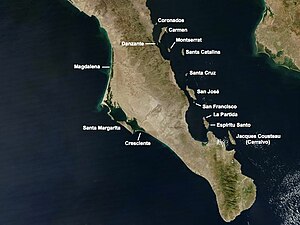Isla San José (Mexico)
| Isla San José | ||
|---|---|---|
| Gulf of California island map | ||
| Waters | Gulf of California | |
| Geographical location | 24 ° 58 ′ N , 110 ° 37 ′ W | |
|
|
||
| length | 31 km | |
| width | 10 km | |
| surface | 182.962 km² | |
| Highest elevation | 633 m | |
| Residents | uninhabited | |
The Isla San José is an island in the south of the Gulf of California off the coast of Baja California .
It is located 60 km north of the city of La Paz and belongs to the municipality of La Paz in the state of Baja California Sur . It is 182.962 km² and is the sixth largest island in Mexico. It reaches a height of 633 meters.
The Isla San José is a breeding area for the yellow-legged gull . There is an abundance of fish species in the waters around the island. Since 2005, the island has been a UNESCO World Heritage Site along with 243 others in the Gulf of California .
Flora and fauna
Compared to other islands in the Gulf of California, Isla San José is characterized by a comparatively rich flora and fauna. The typical vegetation of the desert island include various desert trees, cacti and shrubs, including Fouquieria digueti , Jatropha cinerea , Pachicerus pringley , Opuntia cholla , Bursera hindsiana , Bursera microphylla , Simmondsia chinensis , Cercidium peninsular , Stenocereus gummosus , Cyrtocarpa edulis , Esenbeckia flava , Lycium sp. and Olneya tesota .
The mammalian fauna consists of seven native species. These are the mule deer ( Odocoileus hemionus ), the San José shrub rabbit ( Sylvilagus mansuetus ), the San Jose kangaroo rat ( Dipodomys insularis ), the pocket mouse Chaetodipus spinatus , the American bush rat Neotoma lepida ( Bassariscus , the North American cat frett astutus ) and the cactus mouse ( Peromyscus eremicus ). In addition, cats, dogs, goats, and rats were introduced by humans.
Other native species are various snakes like the rattlesnakes Crotalus enyo enyo , C. mitchellii and C. ruber lucanensis that bull snakes Pituophis melanoleucus bimaris and P. vertebral and masticophis flagellum ( Masticophis flagellum ) and the lizard Cnemidophorus tigris and the zebra-tailed lizard ( Callisaurus draconoides ). Among the birds are the osprey ( Pandion haliaetus ), the red-tailed buzzard ( Buteo jamaicensis ), the peregrine falcon ( Falco peregrinus ) and the great spotted falcon ( Falco sparverius ).
Individual evidence
- ↑ Instituto Nacional de Estadística y Geografía ( Memento of the original of July 22, 2011 in the Internet Archive ) Info: The archive link was inserted automatically and has not yet been checked. Please check the original and archive link according to the instructions and then remove this notice.
- ↑ Sailing Directions (enroute) Pub. 153, 3.13 Isla San Jose (PDF; 3.3 MB)
- ↑ Rocky-reef fish assemblages at San José Island, México (PDF; 694 kB)
- ↑ Iles et aires protégées du Golfe de Californie
- ↑ a b Sylvilagus mansuetus in the endangered Red List species the IUCN 2011. Posted by: S. Álvarez Castañeda, C. Lorenzo, 2008. Accessed July 8 2012th
- ^ Howard H. Thomas, Troy L. Best : Sylvilagus mansuetus . In: Mammalian Species . tape 464 , 1994, pp. 1–2 ( full text (PDF; 219 kB)).

